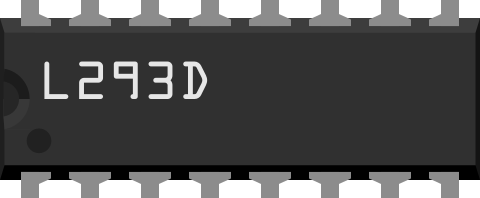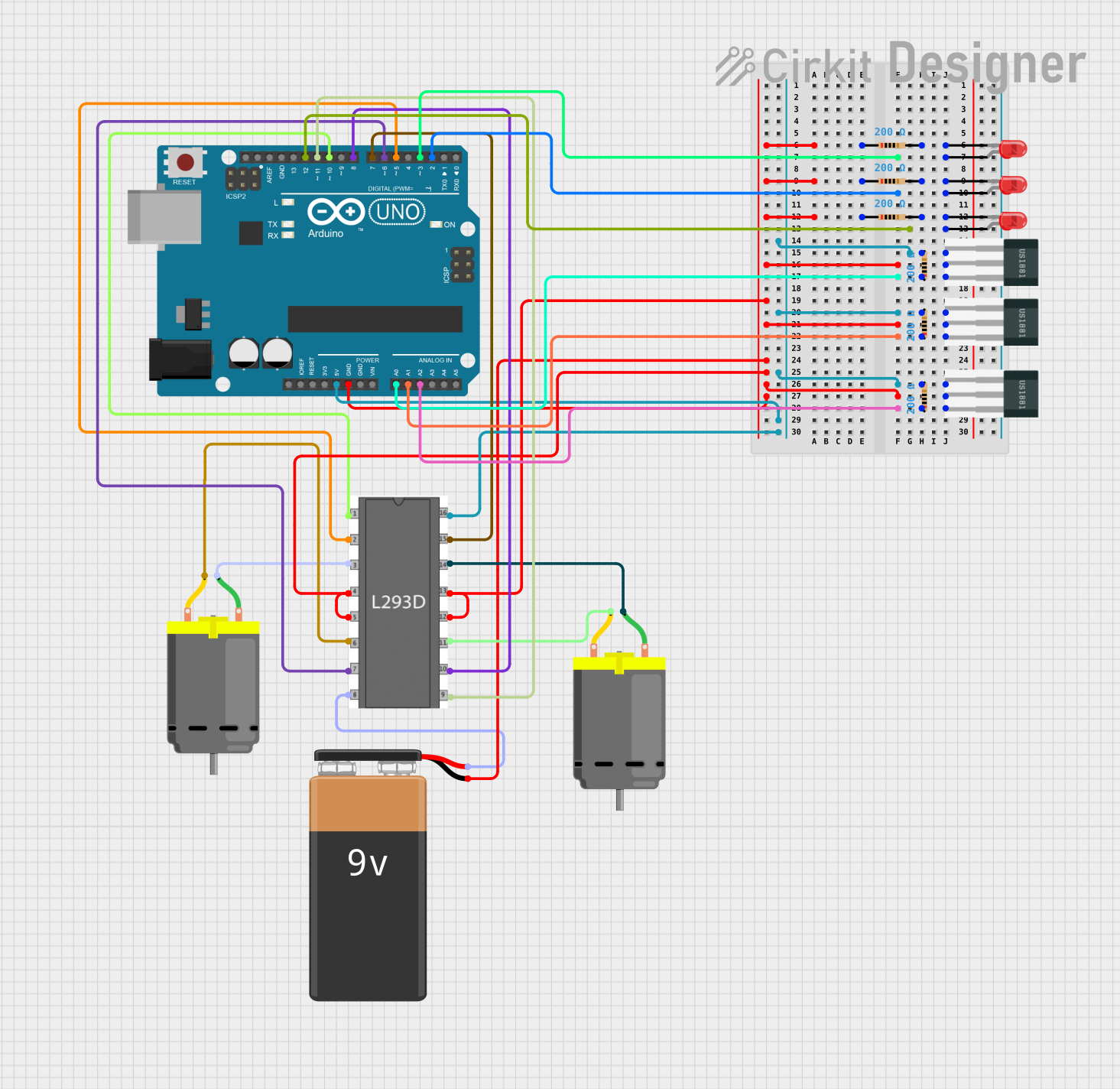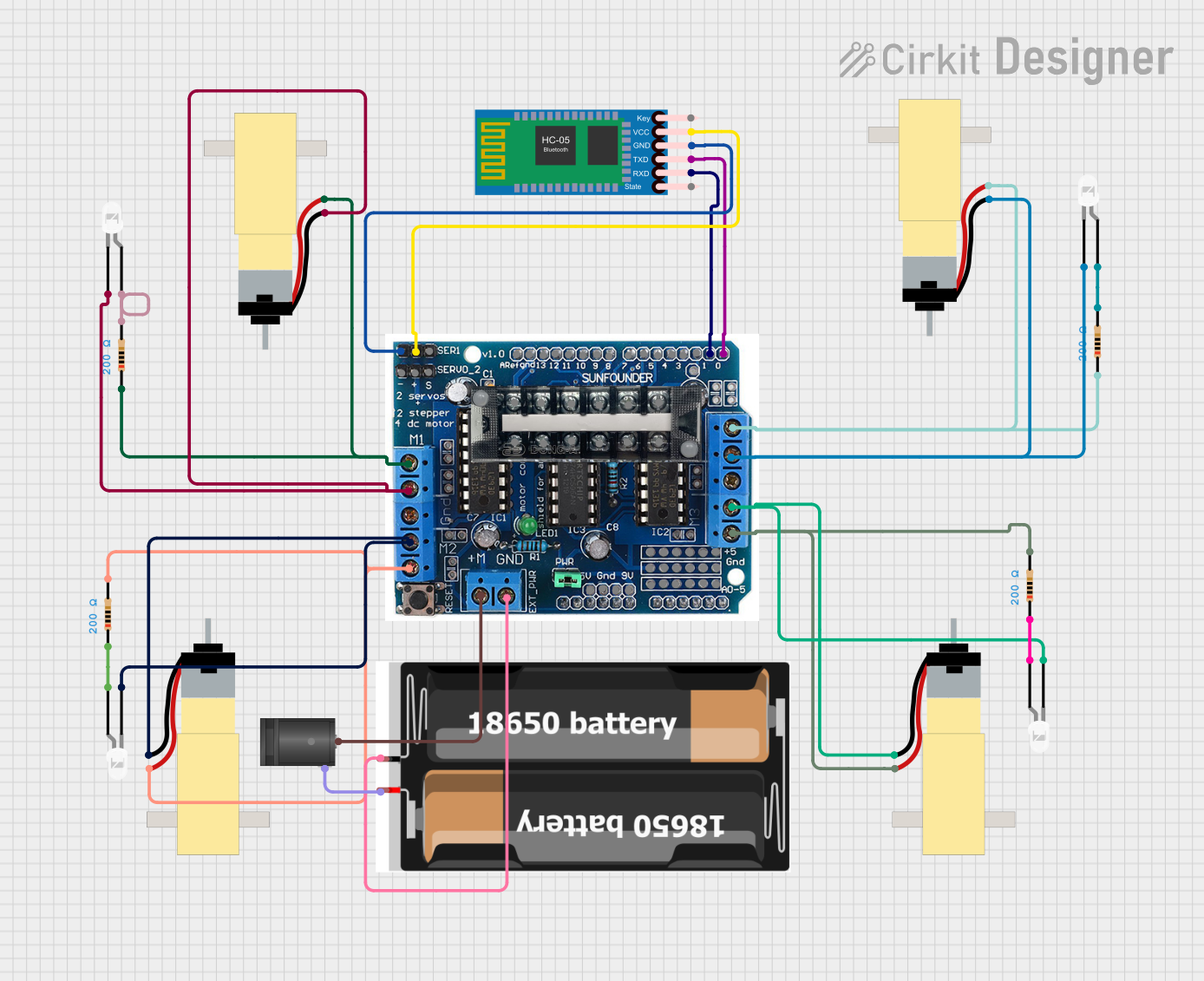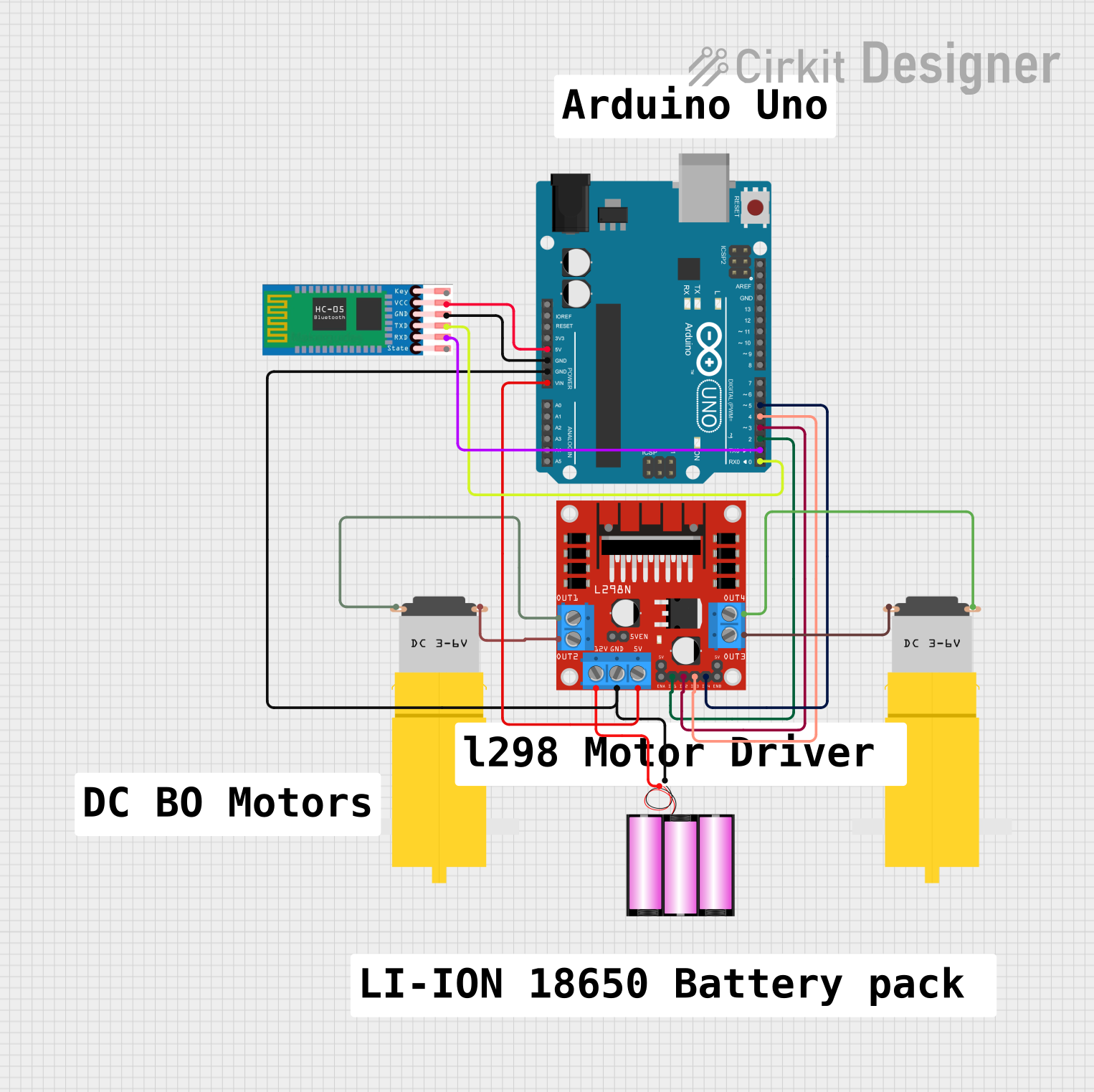
How to Use L293D H-Bridge: Examples, Pinouts, and Specs

 Design with L293D H-Bridge in Cirkit Designer
Design with L293D H-Bridge in Cirkit DesignerIntroduction
The L293D H-Bridge is a dual H-bridge motor driver IC designed to control the direction and speed of DC motors and stepper motors. It is widely used in robotics, automation, and other motor control applications. The IC can drive two motors simultaneously, with each motor's direction and speed independently controlled. Additionally, the L293D includes built-in diodes for back EMF protection, ensuring the safety of the circuit and the IC itself.
Explore Projects Built with L293D H-Bridge

 Open Project in Cirkit Designer
Open Project in Cirkit Designer
 Open Project in Cirkit Designer
Open Project in Cirkit Designer
 Open Project in Cirkit Designer
Open Project in Cirkit Designer
 Open Project in Cirkit Designer
Open Project in Cirkit DesignerExplore Projects Built with L293D H-Bridge

 Open Project in Cirkit Designer
Open Project in Cirkit Designer
 Open Project in Cirkit Designer
Open Project in Cirkit Designer
 Open Project in Cirkit Designer
Open Project in Cirkit Designer
 Open Project in Cirkit Designer
Open Project in Cirkit DesignerCommon Applications
- Robotics: Controlling wheels or robotic arms
- Automation systems: Conveyor belts, actuators
- DIY projects: Remote-controlled cars, drones
- Stepper motor control for CNC machines or 3D printers
Technical Specifications
The L293D is a robust and versatile motor driver IC. Below are its key technical details:
| Parameter | Value |
|---|---|
| Supply Voltage (Vcc1) | 4.5V to 7V |
| Motor Supply Voltage (Vcc2) | 4.5V to 36V |
| Output Current (per channel) | 600mA (peak: 1.2A) |
| Logic Input Voltage | 0V to 7V |
| Operating Temperature | -40°C to +150°C |
| Built-in Protection | Back EMF diodes |
| Number of Channels | 2 (dual H-bridge) |
Pin Configuration and Descriptions
The L293D has 16 pins, each serving a specific purpose. Below is the pinout and description:
| Pin Number | Pin Name | Description |
|---|---|---|
| 1 | Enable 1,2 | Enables H-bridge 1 (controls motor 1). High = Enabled, Low = Disabled. |
| 2 | Input 1 | Logic input for H-bridge 1. Controls motor 1 direction. |
| 3 | Output 1 | Output for H-bridge 1. Connect to one terminal of motor 1. |
| 4 | GND | Ground connection. |
| 5 | GND | Ground connection. |
| 6 | Output 2 | Output for H-bridge 1. Connect to the other terminal of motor 1. |
| 7 | Input 2 | Logic input for H-bridge 1. Controls motor 1 direction. |
| 8 | Vcc2 | Motor supply voltage (4.5V to 36V). |
| 9 | Enable 3,4 | Enables H-bridge 2 (controls motor 2). High = Enabled, Low = Disabled. |
| 10 | Input 3 | Logic input for H-bridge 2. Controls motor 2 direction. |
| 11 | Output 3 | Output for H-bridge 2. Connect to one terminal of motor 2. |
| 12 | GND | Ground connection. |
| 13 | GND | Ground connection. |
| 14 | Output 4 | Output for H-bridge 2. Connect to the other terminal of motor 2. |
| 15 | Input 4 | Logic input for H-bridge 2. Controls motor 2 direction. |
| 16 | Vcc1 | Logic supply voltage (4.5V to 7V). |
Usage Instructions
How to Use the L293D in a Circuit
Power Connections:
- Connect Vcc1 (pin 16) to a 5V supply for the IC's logic circuitry.
- Connect Vcc2 (pin 8) to the motor's supply voltage (4.5V to 36V).
- Connect all GND pins (4, 5, 12, 13) to the ground of the power supply.
Motor Connections:
- Connect the motor terminals to the output pins (3 and 6 for motor 1, 11 and 14 for motor 2).
Control Logic:
- Use the input pins (2, 7 for motor 1; 10, 15 for motor 2) to control the direction of the motors.
- Enable the H-bridges by setting the enable pins (1 for motor 1, 9 for motor 2) to HIGH.
Direction Control:
- Set the input pins HIGH or LOW to control the motor's direction:
- Input1 = HIGH, Input2 = LOW → Motor rotates in one direction.
- Input1 = LOW, Input2 = HIGH → Motor rotates in the opposite direction.
- Set the input pins HIGH or LOW to control the motor's direction:
Speed Control:
- Use a PWM signal on the enable pins (1 and 9) to control the motor speed.
Example: Connecting to an Arduino UNO
Below is an example of how to control a single DC motor using the L293D and an Arduino UNO:
// Define pins for motor control
const int enablePin = 9; // Enable pin for motor 1
const int input1 = 2; // Input 1 for motor 1
const int input2 = 3; // Input 2 for motor 1
void setup() {
// Set motor control pins as outputs
pinMode(enablePin, OUTPUT);
pinMode(input1, OUTPUT);
pinMode(input2, OUTPUT);
// Initialize motor in stopped state
digitalWrite(enablePin, LOW);
digitalWrite(input1, LOW);
digitalWrite(input2, LOW);
}
void loop() {
// Rotate motor in one direction
digitalWrite(enablePin, HIGH); // Enable motor
digitalWrite(input1, HIGH); // Set direction
digitalWrite(input2, LOW);
delay(2000); // Run for 2 seconds
// Stop motor
digitalWrite(enablePin, LOW); // Disable motor
delay(1000); // Wait for 1 second
// Rotate motor in the opposite direction
digitalWrite(enablePin, HIGH); // Enable motor
digitalWrite(input1, LOW); // Set direction
digitalWrite(input2, HIGH);
delay(2000); // Run for 2 seconds
// Stop motor
digitalWrite(enablePin, LOW); // Disable motor
delay(1000); // Wait for 1 second
}
Important Considerations
- Ensure the motor's current and voltage ratings are within the L293D's limits.
- Use proper heat dissipation methods if the IC gets too hot during operation.
- Always connect all ground pins to ensure proper operation.
Troubleshooting and FAQs
Common Issues
Motor Not Spinning:
- Check if the enable pin is set HIGH.
- Verify the input pin logic levels.
- Ensure the motor is properly connected to the output pins.
Motor Spins in the Wrong Direction:
- Reverse the logic levels on the input pins (e.g., swap HIGH and LOW).
IC Overheating:
- Ensure the motor's current does not exceed 600mA per channel.
- Use a heat sink if necessary.
No Output Voltage:
- Verify the power supply connections to Vcc1 and Vcc2.
- Check for loose or incorrect wiring.
FAQs
Q: Can the L293D drive stepper motors?
A: Yes, the L293D can drive stepper motors by controlling the sequence of inputs to the H-bridges.
Q: Can I use the L293D with a 3.3V microcontroller?
A: Yes, but ensure that the logic HIGH voltage from the microcontroller is sufficient to meet the L293D's input voltage requirements.
Q: What is the maximum motor voltage the L293D can handle?
A: The L293D can handle motor supply voltages up to 36V on Vcc2.